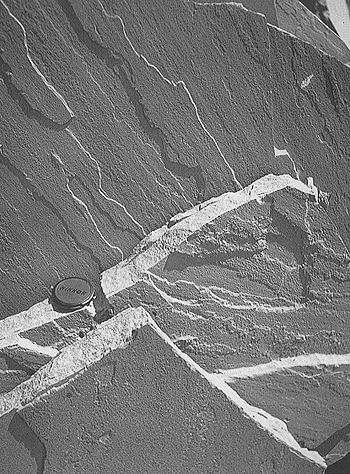
Current lineation on parting planes
Plate 43

Current lineation on parting planes
Plate 43
Laminated sandstones can split apart along surfaces roughly corresponding to planes of laminae. Primary lamination and the ensuing diagenesis impart fissility to the rock, a property that helps both natural weathering (for instance, through freezing and thawing) and artificial sawing in quarries. Parting planes are smooth or slightly terraced. In both cases, they show, when the incident light makes a small angle with them, parallel strings of sand grains. This is a primary character produced by the tractive flow, which sorts and aligns the grains according to their texture and hydraulic behavior. A minor structure results, which is parallel to the paleoflow and is called primary lineation (to distinguish it from other kinds of lineations caused by tectonic processes). Which way the fluid moved along these lines cannot be detected.
The "fresh" surface of the sandstone slabs in the picture (no lichens, no coating of altered minerals) makes clear that quarries are privileged places for looking at rocks. They provide artificial outcrops, often of large size, in areas where the rocks are not or less easily observable because of vegetation or soil cover. On the other hand, quarries are dangerous places, whether they are active or abandoned. Visits must be authorized, and caution is needed in walking too close to cliffs and tailing piles: there is a certain risk of block fall or slide.
Quite often you are not welcome in quarries not so much for security reasons but because owners and managers suspect you are an ecologist or some kind of officer trying to discover infringements to law or environmental wrongdoing.